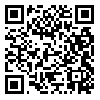Volume 13, Issue 4 (Oct & Nov 2019)
payavard 2019, 13(4): 291-301 |
Back to browse issues page
Download citation:
BibTeX | RIS | EndNote | Medlars | ProCite | Reference Manager | RefWorks
Send citation to:



BibTeX | RIS | EndNote | Medlars | ProCite | Reference Manager | RefWorks
Send citation to:
Moradi M, Bahrami Nia S. The Study of Health Literacy of Patients Referring to Specialist Physicians' Offices in Kermanshah City. payavard 2019; 13 (4) :291-301
URL: http://payavard.tums.ac.ir/article-1-6851-en.html
URL: http://payavard.tums.ac.ir/article-1-6851-en.html
1- Assistant Professor, Department of Information Science and Knowledge, Faculty of Social Sciences, Razi University, Kermanshah, Iran
2- Ph.D. Candidate in Information Science and Knowledge, Faculty of Educational Sciences and Psychology, Payam-e-Noor University of Mashhad, Mashhad, Iran ,bahramisaraa@gmail.com
2- Ph.D. Candidate in Information Science and Knowledge, Faculty of Educational Sciences and Psychology, Payam-e-Noor University of Mashhad, Mashhad, Iran ,
Abstract: (2677 Views)
Background and Aim: The aim of this study was to evaluate the health literacy of patients referring to specialist physicians' offices in the city of Kermanshah.
Materials and Methods: This is a descriptive analytical cross-sectional study. The population of the study (patients and their companions) included those referring to specialist physicians' offices. In 2017, 380 people were randomly selected and were studied during three months. The data collection tool was Health Literacy for Iranian Adults Assessment Questionnaire. Its validity was confirmed by specialists and its reliability turned out to be 0.89 by Cronbach's alpha. Data were analyzed by statistical tests (Spearman's correlation, Mann–Whitney U test and Kruskal-Wallis test) using SPSS software.
Results: The findings of the study showed that the health literacy of patients and their relatives, referring to physicians' offices in the city of Kermanshah, was relatively favorable, i.e., more than average. The three sources of "the Internet", "questions asked from doctors and medical staff" and "radio and television" are the priorities of information or health literacy. The results showed that people's health literacy was different in terms of age, sex, education, and occupation.
Conclusion: The results of this study revealed that often those people who have low and limited health literacy are among vulnerable community groups (having old ages, low educational levels, and low income). So, considering the health information needs and health literacy of vulnerable groups and designing simple and targeted education using the appropriate media are recommended.
Materials and Methods: This is a descriptive analytical cross-sectional study. The population of the study (patients and their companions) included those referring to specialist physicians' offices. In 2017, 380 people were randomly selected and were studied during three months. The data collection tool was Health Literacy for Iranian Adults Assessment Questionnaire. Its validity was confirmed by specialists and its reliability turned out to be 0.89 by Cronbach's alpha. Data were analyzed by statistical tests (Spearman's correlation, Mann–Whitney U test and Kruskal-Wallis test) using SPSS software.
Results: The findings of the study showed that the health literacy of patients and their relatives, referring to physicians' offices in the city of Kermanshah, was relatively favorable, i.e., more than average. The three sources of "the Internet", "questions asked from doctors and medical staff" and "radio and television" are the priorities of information or health literacy. The results showed that people's health literacy was different in terms of age, sex, education, and occupation.
Conclusion: The results of this study revealed that often those people who have low and limited health literacy are among vulnerable community groups (having old ages, low educational levels, and low income). So, considering the health information needs and health literacy of vulnerable groups and designing simple and targeted education using the appropriate media are recommended.
Keywords: Patient, Patient's Companion, Health Literacy, Health Literacy for Iranian Adults Questionnaire, Kermanshah City
Type of Study: Original Research |
Subject:
Medical Library & Information Sciences
ePublished: 1399/07/23
ePublished: 1399/07/23
Send email to the article author
| Rights and permissions | |
 |
This work is licensed under a Creative Commons Attribution-NonCommercial 4.0 International License. |





